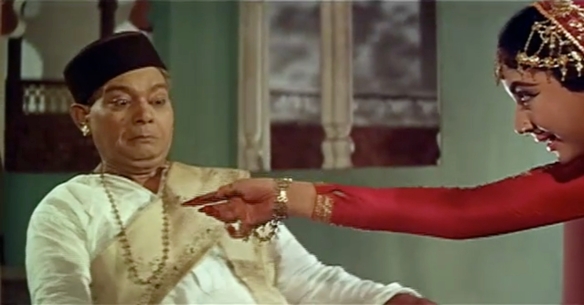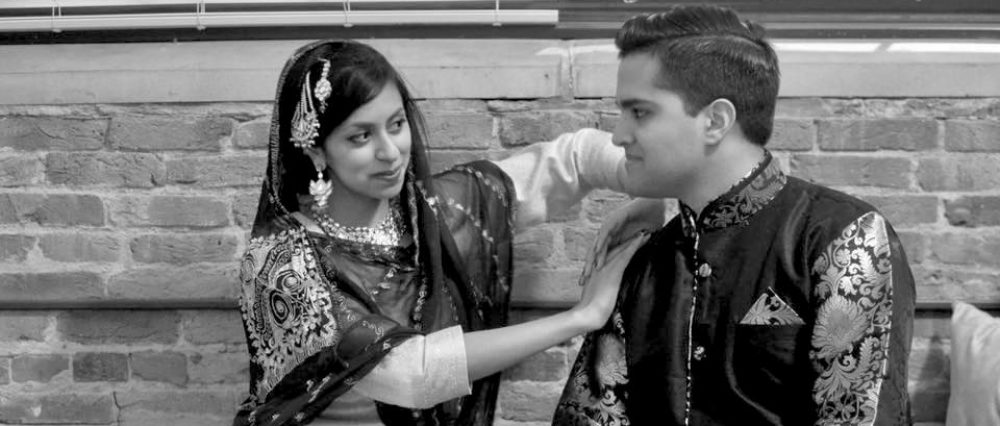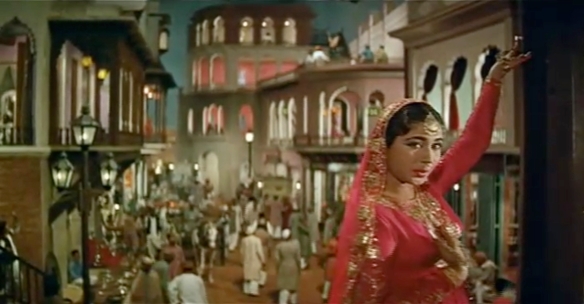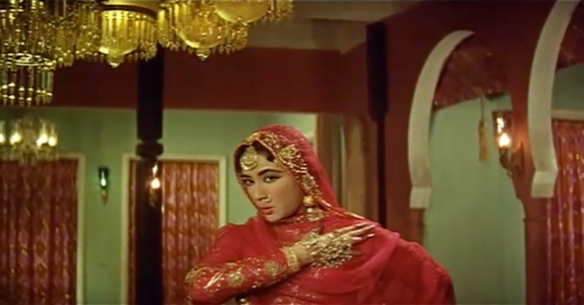Today, we continue our series on the eternally beautiful Pakeezah (1972) by providing the lyrics and English translation to inhii.n logo.n ne, a classic gem that has defined the genre of Bollywood mujras since its release.
Tuned by Ghulam Mohammed and penned by Majrooh Sultanpuri, this song was perhaps the most widely appreciated number (it reached #2 on the 1972 Binaca Geet Mala list!) from a soundtrack full of memorable compositions like chalte chalte and mausam hai aashiqaanaa. Although its light, Yaman-based melody evokes a playful sprit, the underlying tragedy expressed in the lyrics of this song is unexpectedly ironic. In spite of the pain she suffers from being stigmatized as a tavaaif, Meena Kumari is forced to render this mujraa with verve and a smile for her patrons at the brothel. While addressing her beloved saiyaa.n, she laments how the men around her have stolen her innocence and modesty, which is symbolically represented by the loss of her DupaTTaa. To persuade her lover, she implores him to ask three characters in the song to confirm that her virtue was soiled against her will: the cloth merchant, the cloth dyer, and the constable. Representing different facets of society, these characters serve as witnesses to her loss of innocence and sometimes take part in the process (e.g. when the constable snatches her scarf away at the market.) To add to the irony, the red color of the lost scarf and Meena Kumari’s on-screen outfit are reminiscent of the colors adorning a South Asian bride on her wedding day. Yet, the audience is acutely aware that a courtesan in such a position will provoke condemnation and disgust for attempting to engage in the conventional structures of love and marriage established by the society around her.
In addition to carrying a powerful message about social stigma in Indian society, these lyrics are memorable for their apabhransa (corrupt, non-grammatical) use of Urdu-Hindi. Reminiscent of the Awadhi dialect, a number of modifications to modern standard Hindi have been used here for poetic effect:
le liinaa = le liyaa (have taken)
bajajvaa = bajaj (cloth merchant)
hamrii = hamaarii (my, our)
sipaiyaa = sipaahii (constable)
bajariyaa = bazaar (market)
These substitutions really stick in the listener’s mind and give the lyrics of inhii.n logo.n ne a unique linguistic flavor that stands out from other compositions from the same period. Non-standard dialects such as Braj find prominence in classical Hindustani bandishes, but the lyricists for Bollywood cinema of the Golden Age tended to rely on standard Urdu-Hindi for most of their work.
Songs like inhii.n logo.n ne have historically cast a sympathetic light on the tragic lives led by courtesans of yesteryear, and it is a well-known fact that fans have been fascinated with this genre of music and movies since the earliest days of the Hindi film industry. To conclude, I’ll leave you with a thought-provoking question: given the conservative social climate of 1960s and 1970s India, why did courtesan-based films (e.g. Pakeezah, Mughal-e-Azam, Amar Prem) resonate intimately with Indian audiences? Although deep-seated stigmas surround tavaaifs and their profession, what is the driving force behind India’s obsession with the story of a courtesan with a heart of gold? Let us know your thoughts in the comments!
-Mr. 55
P.S. Check out a rare black and white version of this song filmed on a younger Meena Kumari in 1956 (16 years before the film’s eventual release)!

Meena Kumari’s playful spirit in ‘inhii.n logo.n ne‘ belies the tragic reality of her profession as a courtesan in Pakeezah (1972).
Inhi Logon Ne: Lyrics and Translation
inhii.n logo.n ne, inhii.n logo.n ne
These people, these people
inhii.n logo.n ne le liina DupaTTaa meraa
These people have taken away my scarf of modesty.
hamrii na maano, saiyaa.n, bajajvaa se puuchho
If you don’t accept my word, oh beloved, ask the cloth merchant
jis ne asharfii gaj diinaa DupaTTaa meraa
who sold me a yard of its fabric for a gold coin.
hamrii na maano, saiyaa.n, ra.ng rajvaa se puuchho
If you don’t accept my word, oh beloved, ask the cloth dyer
jis ne gulaabii ra.ng diinaa DupaTTaa meraa
who gave my scarf its pink color.
hamrii na maano, saiyaa.n, sipaiyaa se puuchho
If you don’t accept my word, oh beloved, ask the constable
jis ne bajariyaa me.n chhiinaa DupaTTaa meraa
who stripped away my scarf at the market.
inhii.n logo.n ne le liinaa DupaTTaa meraa
These people have taken away my scarf of modesty.
Glossary
le lenaa: to take away; DupaTTaa: a long scarf covering a woman’s chest, a traditional symbol of modesty and honor for Indian women; hamrii (baat): my word; maannaa: to accept, believe; bajajvaa: cloth merchant; asharfii: a gold coin issued by Muslim dynasties; gaj: a unit of measurement equivalent to a yard; saiyaa.n: beloved; rang rajvaa: cloth dyer; gulaabii: pink; sipaiyaa: constable; bajariyaa: market; chiinnaa: to strip away.



Once again a great article
Very well written post 🙂
This song is almost like a folk song in lyrical style, isn’t it?
Why does the “rare black & white version” of the song take me to an asharfi ad ?! Here’s where the hyperlink leads to : http://ahmedabad.olx.in/antique-gold-silver-asharfi-coins-of-mughal-period-for-sale-iid-309672674
I think that one reason these films were favourably received in the 50’s, 60’s and 70’s is because of the implicit knowledge people had, of the fact that most women engaged in the flesh trade, were not in it by choice. E.g. For Sahebjaan in ‘Pakeezah’ her profession was something she was born into, with it being near impossible for women trapped in it to effectively extricate themselves from it. Her mother Nargis attempts to do so with disastrous results: rejection from her lover’s family, heartbreak and ultimately she dies after giving birth to Sahebjaan. Even for women who were in it, through no fault of their own and desperately trying to get out, integration into normal society must have been very difficult with acceptance from others often being withheld. It may be a slightly romanticised idea of the courtesan/prostitute, but even today, at least in the Indian subcontinent, I think that most women in the profession must be there out of really terrible circumstances, with there often being a strong coercive element present. In cases like this, how can anyone not feel compassion and sympathy.
Also, the Indian literary tradition appears to be replete with examples of authors engaging with this theme, and evincing strong concern for women in this predicament. I haven’t actually read their texts, but writers such as Sarat Chandra, Munshi Premchand, Sarfraz Husain Azmi and Manto all dealt with the institution of prostitution in their writings. I guess filmmakers had a fairly long-standing literary tradition to draw upon, and probably knew that audiences weren’t likely to be unreceptive. In ‘Pakeezah’ itself, Amrohi has not presented the figure of the ‘pure-prostitute’ as some kind of anomaly or paradox; Sahibjaan is not some kind of exception but is representative of many thousands of other such women. Right at the end of the ‘Inhi Logo Ne’ song you have Sahibjaan spinning with her dupatta in the air, and in the background are several other such dancing girls turning on the rooftops like her. The effect is not only visually spectacular, but is strongly symbolic: Pakeezah is one amongst many others. As the film is about to end with the Baraat leaving with Sahibjaan’s Doli, there’s a close-up of a young girls face wistfully watching the marriage procession leave. The girl never appeared before in the film. I was reading an interview with Tajdar Amrohi, who said that when the film editor mistakenly cut the girl’s face out, Amrohi was aghast. He said “Why did you cut her out? She is the very basis for Pakeezah”.
The ‘Inhi Logon Ne’ song itself is amazing (lol…u run out adjectives to describe the songs of Pakeezah…they’re all so magnificent), it is so wonderfully choreographed, and so wonderfully executed. Apparently Meena Kumari was no dancer, but you can’t tell; when she was required to dance she pulled it off with so much grace, and in this song so much energy and sprightly playfulness(this kind of song required that), and of course the lyrics with the strongly satirical content that u discuss; ‘These very people condemn me and yet they’re the ones who took my Dupatta.’ If you observe closely, u can see that there are all kinds of things happening in the background which one would associate with the precincts of a brothel; there’s a street brawl going on, where a third party is called to intervene and break up the fight. It is an amazingly shot song, with it being very difficult to achieve that kind of effect when Amrohi shot it (the early 60’s). Also found it interesting to read about the effect of the use of apabhransa Urdu-Hindi. it definitely added to the song here.
Profound. Thanks
what a wonderful post- I learnt so much about a song and a movie that I thought I was so familiar with.
Congratulations to Mr 55 for once again educating his seniors and surprising them so wonderfully with his erudition and insight
Wonderful I never saw the sad part and now I cant unsee it.
You forgot to mention Teesri Kasam among the movies, stands my favourite.
Illicit love appeals to the most basic of human emotions, sadness. It has and always be relevant.
Hi,
Amazing … Truly amazing…. ! What you have undertaken is just that. It’s a great effort and an admirable one. Kudos to you both for this project. I was totally unaware of such a site. .. and now that I do, there are a hundred songs that come to my mind whose meanings I have wanted to know… for a long time…. I shall ask you questions in the coming days..
Best regards
Anand
Pingback: Teer-e Nazar Dekhenge Lyrics and Translation: Let’s Learn Urdu-Hindi | Mr. & Mrs. 55 - Classic Bollywood Revisited!
talking about lyricists (and shaaiyars)…..those of the 50/60/70 eras were indeed poets whose magical words not only blended with the scripts, but were also, reflective of the moods of some of those poets (example sahir)……………..they were poets,
todays lyricists are pop writers whose songs will not last the test of time (with due respect
sameer, prasoon, amitabh etc etc)
my favorite was shakeel badayuni-
not only because he won three consecutive filmfares,
but his magical words in mere mehboob were just heart warming-peotry of the highest calibre..
then, sahir, majrooh, shailendra, hasrat my top 5………………………….
followed by rajindra jrishan, kaifi azmi, raja mehdi (who, both, wrote few songs), indivar and asad bhopali…………….
.of the current or post 7o’s era crop———— i will give anand bakshi full marks .
……….thereafter javed akhtar
I think another unique thing about this song is the angles it uses while filming. Though the focus is on Meena Kumari, but if you look behind her you can see many other courtesans in their own brothels dancing ( similar to the two dancer effect in Chalte Chalte). The unique thing is if you observe closely sometimes those dancers are in tune and sometimes out of tune. I think the effect is to make Meena Kumari stand out and look even more beautiful. Even the camera angles play back and forth to scenes with the brothels behind her to focusing just on her.
Were not many of the makers, actresses and performers of early Indian cinema steeped in, if not directly from, the old world of the courtesans? Perhaps this is why they showed a particular fascination and sympathy for that milieu.
I think that’s an interesting point! Perhaps more broadly, they could empathize with the beauty of fellow artists particularly as even the Hindi film industry was considered very taboo by much of society in that time.
Thank you so much for this article. With Lataji’s recent passing, I’ve been going through her classics and it’s been very emotional. I’m Bengali so I never actually understood the meaning of any Bollywood songs. The Pakeezah soundtrack cassette was played so much at home that every song sounds familiar, but my parents weren’t the type to explain complex social issues, especially not to a small child. Thank you for filling in the gaps with such nuance, Uncle & Auntie 55. 🙂